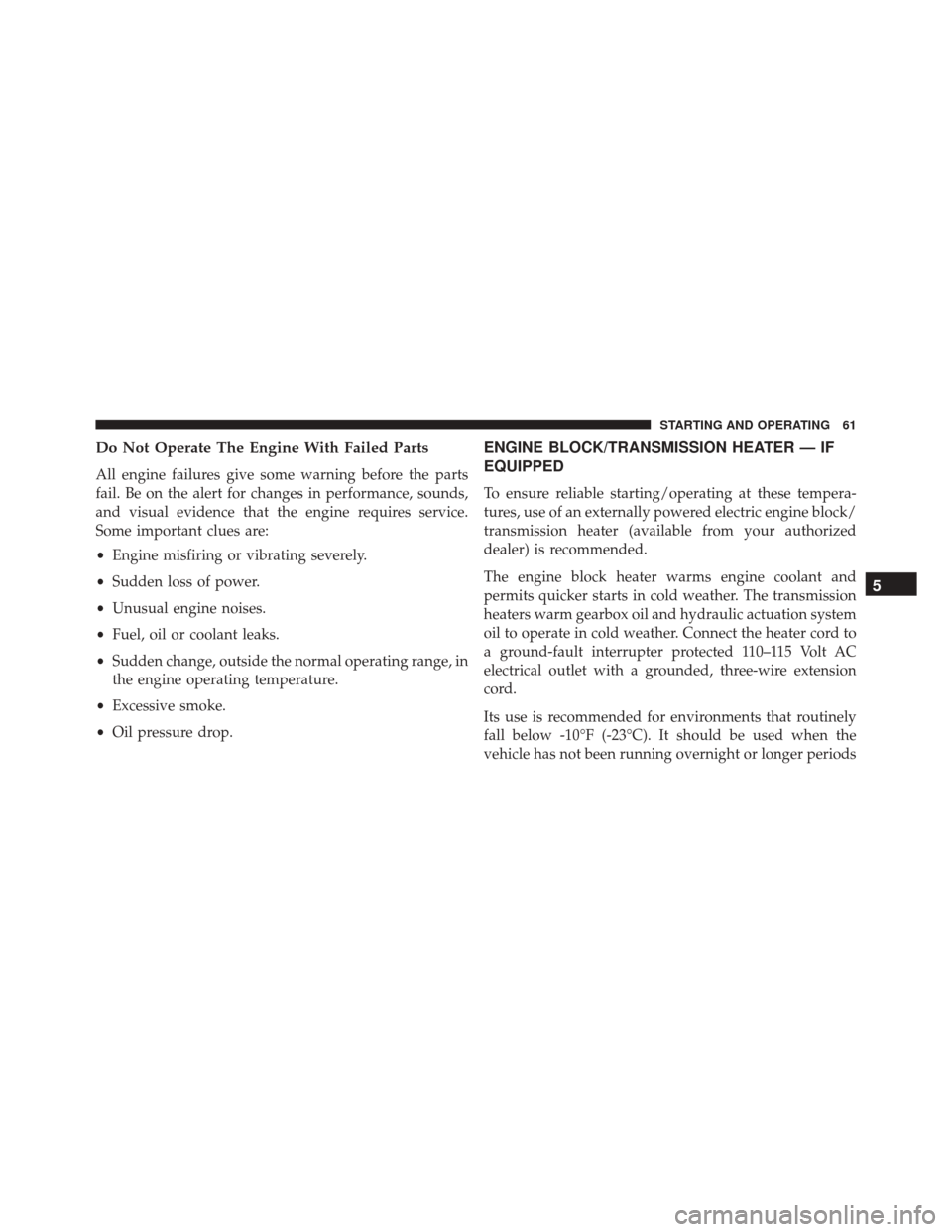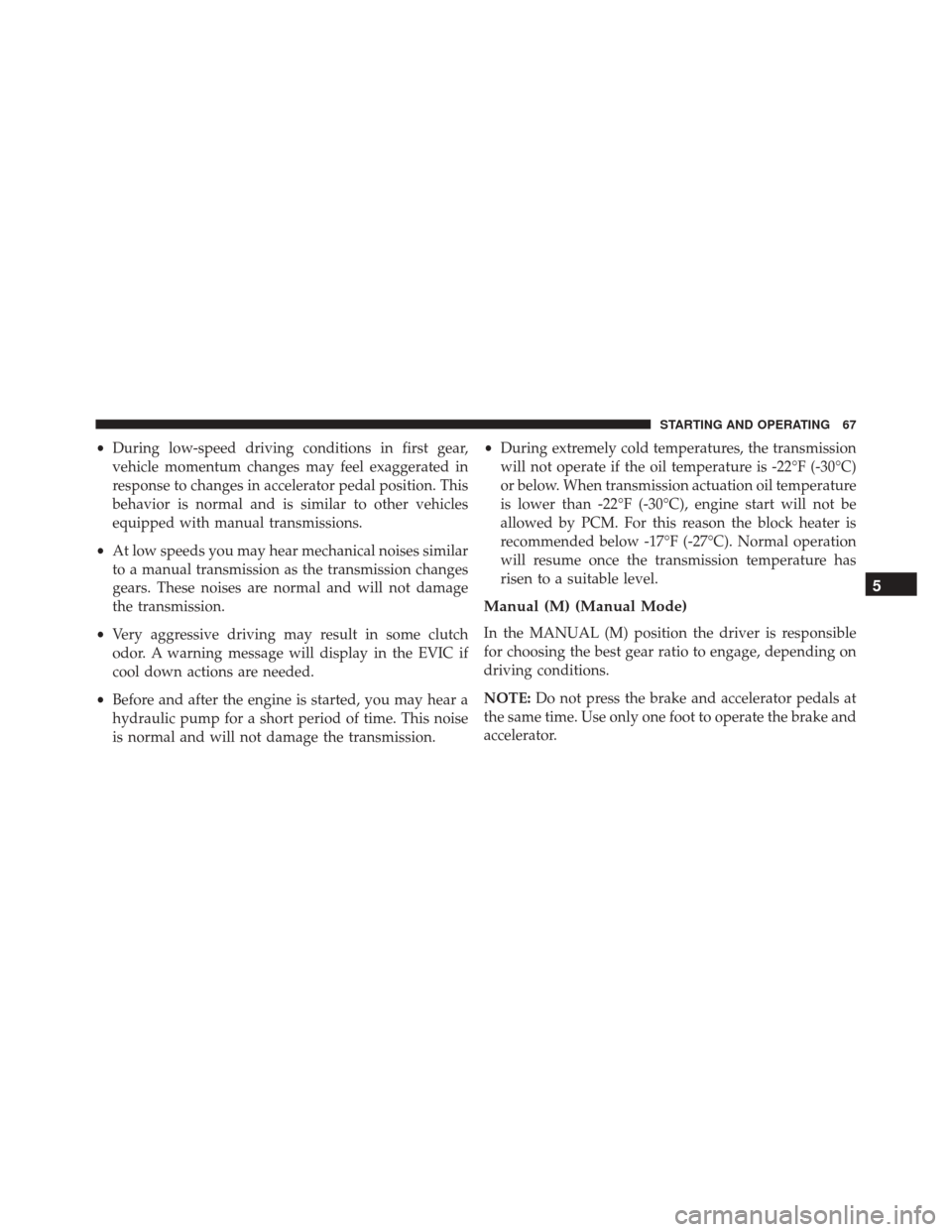Page 62 of 145

Cooling System Tips — Automated Manual
Transmission
To reduce potential for engine and transmission over-
heating in high ambient temperature conditions, take the
following actions:
•City Driving
— When stopped, shift the transmis-
sion into NEUTRAL and increase engine idle
speed.
• Highway Driving— Reduce your speed.
•Up Steep Hills— Select a lower transmission gear.
•Air Conditioning— Turn it off temporarily. Do Not Operate The Engine With Low Oil
Pressure
If the low oil pressure warning light turns on while
driving, stop the vehicle and shut down the engine as
soon as possible. A chime will sound when the light turns
on.
NOTE:
Do not operate the vehicle until the cause is
corrected. This light does not show how much oil is in the
engine. The engine oil level must be checked under the
hood.
CAUTION!
If oil pressure falls to less than normal readings, shut
the engine off immediately. Failure to do so could
result in immediate and severe engine damage.
60 STARTING AND OPERATING
Page 63 of 145

Do Not Operate The Engine With Failed Parts
All engine failures give some warning before the parts
fail. Be on the alert for changes in performance, sounds,
and visual evidence that the engine requires service.
Some important clues are:
•Engine misfiring or vibrating severely.
• Sudden loss of power.
• Unusual engine noises.
• Fuel, oil or coolant leaks.
• Sudden change, outside the normal operating range, in
the engine operating temperature.
• Excessive smoke.
• Oil pressure drop.
ENGINE BLOCK/TRANSMISSION HEATER — IF
EQUIPPED
To ensure reliable starting/operating at these tempera-
tures, use of an externally powered electric engine block/
transmission heater (available from your authorized
dealer) is recommended.
The engine block heater warms engine coolant and
permits quicker starts in cold weather. The transmission
heaters warm gearbox oil and hydraulic actuation system
oil to operate in cold weather. Connect the heater cord to
a ground-fault interrupter protected 110–115 Volt AC
electrical outlet with a grounded, three-wire extension
cord.
Its use is recommended for environments that routinely
fall below -10°F (-23°C). It should be used when the
vehicle has not been running overnight or longer periods
5
STARTING AND OPERATING 61
Page 69 of 145

•During low-speed driving conditions in first gear,
vehicle momentum changes may feel exaggerated in
response to changes in accelerator pedal position. This
behavior is normal and is similar to other vehicles
equipped with manual transmissions.
• At low speeds you may hear mechanical noises similar
to a manual transmission as the transmission changes
gears. These noises are normal and will not damage
the transmission.
• Very aggressive driving may result in some clutch
odor. A warning message will display in the EVIC if
cool down actions are needed.
• Before and after the engine is started, you may hear a
hydraulic pump for a short period of time. This noise
is normal and will not damage the transmission. •
During extremely cold temperatures, the transmission
will not operate if the oil temperature is -22°F (-30°C)
or below. When transmission actuation oil temperature
is lower than -22°F (-30°C), engine start will not be
allowed by PCM. For this reason the block heater is
recommended below -17°F (-27°C). Normal operation
will resume once the transmission temperature has
risen to a suitable level.
Manual (M) (Manual Mode)
In the MANUAL (M) position the driver is responsible
for choosing the best gear ratio to engage, depending on
driving conditions.
NOTE: Do not press the brake and accelerator pedals at
the same time. Use only one foot to operate the brake and
accelerator.
5
STARTING AND OPERATING 67
Page 108 of 145

which is recommended for all operating temperatures.
This engine oil improves low temperature starting and
vehicle fuel economy.
Materials Added To Engine Oil
The manufacturer strongly recommends against the ad-
dition of any additives (other than leak detection dyes) to
the engine oil. Engine oil is an engineered product and its
performance may be impaired by supplemental addi-
tives.
Engine Oil Filter
Refer to “Fluids, Lubricants, And Genuine Parts” in
“Maintaining Your Vehicle” for further information. The
engine oil filter should be changed at every engine oil
change.
Disposing Of Used Engine Oil And Oil Filters
Care should be taken in disposing of used engine oil and
oil filters from your vehicle. Used oil and oil filters,
indiscriminately discarded, can present a problem to the
environment. Contact your authorized dealer, service
station or governmental agency for advice on how and
where used oil and oil filters can be safely discarded in
your area.
Engine Air Cleaner Filter
Refer to the “Maintenance Schedule” for the proper
maintenance intervals.
CAUTION!
All air entering the engine intake must be filtered.
The abrasive particles in unfiltered air will cause
rapid wear to engine components.
106 MAINTAINING YOUR VEHICLE
Page 128 of 145

MAINTENANCE SCHEDULE — DIESEL ENGINE
Your vehicle is equipped with an automatic oil change
indicator system. The oil change indicator system will
remind you that it is time to take your vehicle in for
scheduled maintenance.
Based on engine operation conditions, the oil change
indicator message will illuminate in the instrument clus-
ter. This means that service is required for your vehicle.
Operating conditions such as frequent short-trips, trailer
tow, and extremely hot or cold ambient temperatures will
influence when the “Oil Change Required” message is
displayed. Severe Operating Conditions can cause the
change oil message to illuminate as early as 3,500 miles
(5,600 km) since last reset. Have your vehicle serviced as
soon as possible, within the next 500 miles (805 km).
Your authorized dealer will reset the oil change indicator
message after completing the scheduled oil change. If a
scheduled oil change is performed by someone otherthan your authorized dealer, the message can be reset by
referring to the steps described under “Electronic Vehicle
Information Center (EVIC)” in “Understanding Your
Instrument Panel” for further information.
NOTE:
Under no circumstances should oil change inter-
vals exceed 18,500 miles (29,773 km) or twelve months,
whichever comes first.
Once A Month Or Before A Long Trip:
• Check engine oil level
• Check windshield washer fluid level
• Check the tire inflation pressures and look for unusual
wear or damage
• Check the fluid levels of the coolant reservoir, brake
master cylinder, and power steering and fill as needed
• Check function of all interior and exterior lights
126 MAINTENANCE SCHEDULE
Page 140 of 145

Filter............................ .107, 120
Requirements ....................... .76, 119
Specifications ...........................78
Tank Capacity ..........................119
Gear Ranges ..............................64
Gross Axle Weight Rating ....................89
Gross Vehicle Weight Rating ..................88
Hitches Trailer Towing ..........................91
Information Center, Vehicle ...................48
Instrument Cluster ..................14, 22, 24, 44
Intervention Regeneration Strategy .............110
Lights AirBag ...............................19
Brake Warning ..........................26 Cruise
............................ .46, 47
Engine Temperature Warning ................22
Malfunction Indicator (Check Engine) ..........37
Park .................................45
Seat Belt Reminder .......................18
Tire Pressure Monitoring (TPMS) .............32
Turn Signal ............................44
Warning (Instrument Cluster Description) . . . .22, 44
Maintenance Procedures ....................103
Maintenance Schedule ..................... .126
Malfunction Indicator Light (Check Engine) .......37
New Vehicle Break-In Period ...................8
Oil, Engine ......................... .104, 120
Capacity ..............................119
Change Interval ....................... .105
Dipstick ............................. .104
138 INDEX